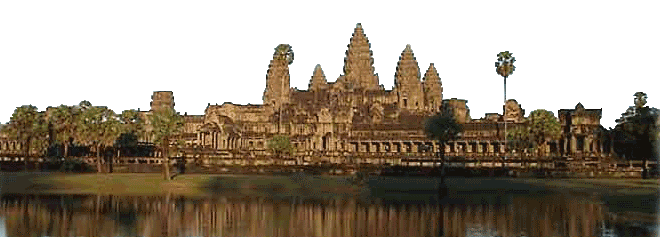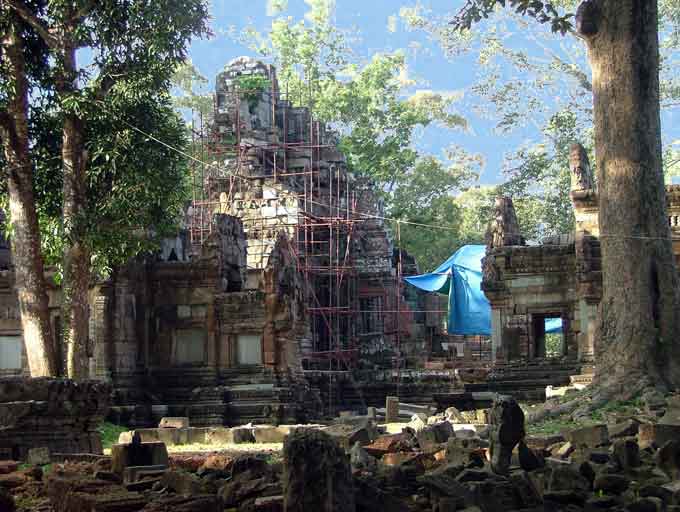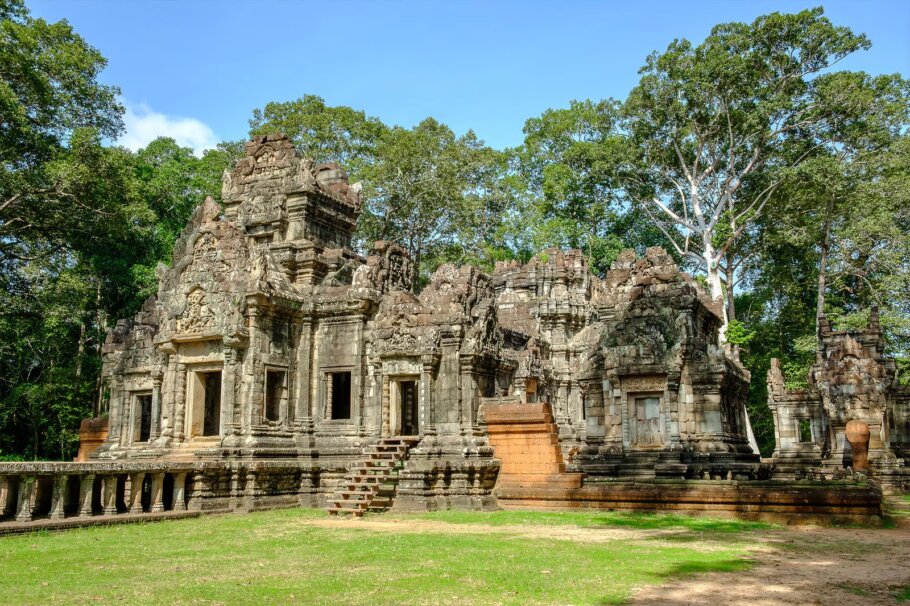Cambodge temple d'Angkor - Chau Say Tevoda

Cambodge temple d'Angkor
CHAU SAY TEVODA*
Constructed Early 12 th century
Religion : Hindu
Style Angkor Wat
King Suryavarman VII
Location :
On the small circuit, on the right side while leaving Angkor Thom by Victory Gate, opposite Thomanom.
On the small circuit, on the right side while leaving Angkor Thom by Victory Gate, opposite Thomanom.
Comments:
Chau Say Tevoda is currently under restoration, and it is very interesting to be able to observe the enormous work that that requires: the method used, the anastylose, consists in dismounting the monument item by item then to rebuild it by reconstituting the missing elements. This very hard method applies perfectly to the Khmer monuments and makes it possible to return to them an aspect nearest possible to that of origin contrary to the methods of restorations traditional.
The restoration is illustrated and commented in a small building located near the temple, it is a unique opportunity to understand the vastness of work in progress or to come on the site of Angkor !
Chau Say Tevoda is currently under restoration, and it is very interesting to be able to observe the enormous work that that requires: the method used, the anastylose, consists in dismounting the monument item by item then to rebuild it by reconstituting the missing elements. This very hard method applies perfectly to the Khmer monuments and makes it possible to return to them an aspect nearest possible to that of origin contrary to the methods of restorations traditional.
The restoration is illustrated and commented in a small building located near the temple, it is a unique opportunity to understand the vastness of work in progress or to come on the site of Angkor !
Located northeast of Angkor Thom, Chau Say Tevoda is a Hindu temple built in the late 12th century, likely during the reign of Jayavarman VII or his successors. The name Chau Say Tevoda means "house of victory" or "house of Tevoda's victory" in Khmer (Tevoda being the name of a deity or mythological figure).
This temple adopts a classical plan with an enclosure surrounding the main sanctuary, accessed through several gopuras (gateways). The structure is made of sandstone, adorned with elaborate bas-reliefs depicting mythological scenes, Hindu deities such as Vishnu or Shiva, as well as floral and geometric decorative motifs.
The site also includes pools or ponds, adding to the symmetry and serenity of the complex. The surrounding vegetation contributes to a peaceful and mystical atmosphere. Chau Say Tevoda perfectly illustrates the religious and artistic architecture of the Khmer Empire's heyday. Its symmetrical design, sculpted details, and Hindu influences attest to the cultural and religious richness of the period. Like many of Angkor's temples, it reflects a fusion of power, faith, and technical mastery.
This site is less frequented than the famous Angkor Wat, making it an ideal place to appreciate the tranquil splendor of Khmer architecture and experience its spiritual atmosphere.
Chau Say Tevoda is a remarkable work of Khmer heritage, offering valuable insight into the religious art and engineering of the Angkor Empire. Its architectural beauty and sculptures make it a must-see for anyone wishing to explore the rich history and culture of ancient Cambodia.
Localisation :
Sur le petit circuit, sur la droite en sortant d'Angkor Thom par la Victory Gate, en face de Thomanom.
Sur le petit circuit, sur la droite en sortant d'Angkor Thom par la Victory Gate, en face de Thomanom.
Commentaires :
Chau Say Tevoda est actuellement en cours de rénovation, et il est très intéressant de pouvoir observer l'énorme travail que cela nécessite : la méthode utilisée, l'anastylose, consiste à démonter le monument pièce par pièce puis à le reconstruire en reconstituant les éléments manquants. Cette méthode très laborieuse s'applique parfaitement aux monuments khmers et permet de leur rendre un aspect le plus proche possible de celui d'origine contrairement aux méthodes de restaurations classiques.
La restauration est illustrée et commentée dans un petit bâtiment situé à proximité du temple, c'est une occasion unique de comprendre l'immensité du travail en cours ou à venir sur le site d'Angkor !
Chau Say Tevoda est actuellement en cours de rénovation, et il est très intéressant de pouvoir observer l'énorme travail que cela nécessite : la méthode utilisée, l'anastylose, consiste à démonter le monument pièce par pièce puis à le reconstruire en reconstituant les éléments manquants. Cette méthode très laborieuse s'applique parfaitement aux monuments khmers et permet de leur rendre un aspect le plus proche possible de celui d'origine contrairement aux méthodes de restaurations classiques.
La restauration est illustrée et commentée dans un petit bâtiment situé à proximité du temple, c'est une occasion unique de comprendre l'immensité du travail en cours ou à venir sur le site d'Angkor !
Situé au nord-est d’Angkor Thom, « Chau Say Tevoda » est un temple hindou construit à la fin du XIIe siècle, probablement sous le règne de Jayavarman VII ou de ses successeurs. Le nom « Chau Say Tevoda » signifie en khmer « la maison de la victoire » ou « la maison de la victoire de Tevoda » (Tevoda étant un nom de divinité ou de figure mythologique).
Ce temple adopte un plan classique avec une enceinte entourant la sanctuaire principal, accessible par plusieurs gopuras (portails). La structure est en pierre de grès, ornée de bas-reliefs sophistiqués illustrant des scènes mythologiques, des divinités hindoues comme Vishnu ou Shiva, ainsi que des motifs décoratifs floraux et géométriques.
Le site comprend également des bassins ou étangs, ajoutant à la symétrie et à la sérénité de l’ensemble. La végétation environnante contribue à une atmosphère paisible et mystique.
« Chau Say Tevoda » illustre parfaitement l’architecture religieuse et artistique de l’apogée de l’empire khmer. Sa conception symétrique, ses détails sculptés et ses influences hindoues témoignent de la richesse culturelle et religieuse de l’époque. Comme beaucoup de temples d’Angkor, il reflète une fusion de pouvoir, de foi et de maîtrise technique.
Ce site est moins fréquenté que le célèbre Angkor Wat, ce qui en fait un lieu idéal pour apprécier la splendeur tranquille de l’architecture khmère et pour ressentir l’atmosphère spirituelle qui s’en dégage.
Le « Chau Say Tevoda » est une œuvre remarquable du patrimoine khmer, offrant un aperçu précieux de l’art religieux et de l’ingénierie de l’Empire d’Angkor. Sa beauté architecturale et ses sculptures en font un site incontournable pour quiconque souhaite explorer la richesse historique et culturelle du Cambodge ancien.




